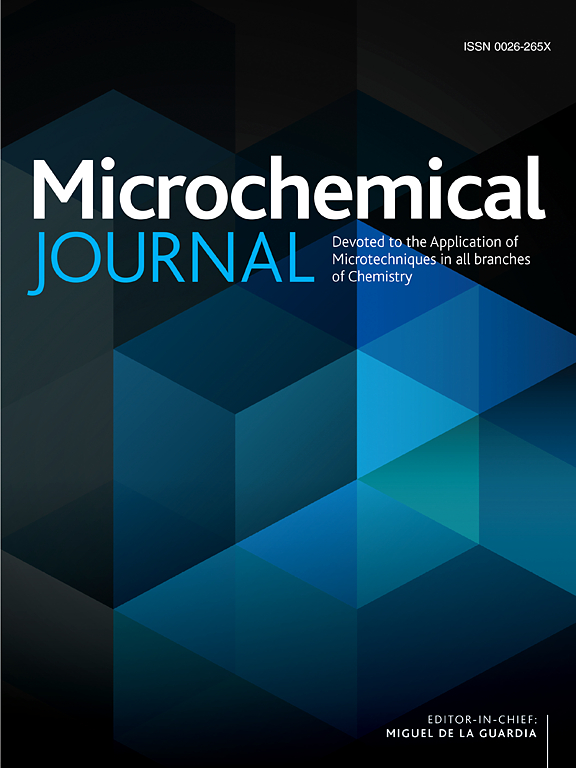Recent advances in pristine/heterojunction bismuth tungstate-based (photo)electrochemical sensing strategies
IF 4.9
2区 化学
Q1 CHEMISTRY, ANALYTICAL
引用次数: 0
Abstract
Photoelectrochemical (PEC) sensors, which combine photocatalytic and electrochemical properties, have become a novel analytical tool. A PEC sensor's notable benefits include in-situ analyses, easy construction, portability, exceptional sensitivity, and cost-effectiveness. This review article presents bismuth tungstate-based electrochemical and photoelectrochemical sensors. Electrochemical sensors include pristine Bi2WO6-based sensors and rGO-Bi2WO6 composite-based sensors. Photoelectrochemical sensors are divided into five sections: pristine Bi2WO6-based sensors, Bi2WO6 heterojunction-based sensors, Bi2WO6 heterojunction-based sensors with hole-trapping agent, Bi2WO6 heterojunction-based label-free biosensors, and Bi2WO6 heterojunction-based sandwich-biosensors. Different heterojunctions have been obtained by associating narrow bandgap semiconductors (WO3, CuS, Fe2O3, Bi2S3, Ag2S, BiOBr, CuS, MoS2, CdS), conductive carbon materials (g-C3N4, RGO), metallic nanoparticles (Au,Ag), or conductive polymers (polypyrrole, polydopamine) with Bi2WO6 crystals. Many sensors and biosensors provide a signal-on detection, whereas some sensors and biosensors, associated with a hole-trapping agent (ascorbic acid, hydrogen peroxide, sulfate), lead to a signal-off detection. Many molecules of health interest (metabolites, biomarkers, drugs) and a few pollutants have been detected with low detection limits. Additionally, the challenges for further large-scale applications of Bi2WO6-based sensors in the fields of health and environmental control are analyzed.

原始/异质结钨酸铋基(光)电化学传感策略的最新进展
光电化学传感器结合了光催化和电化学的特性,已成为一种新型的分析工具。PEC传感器的显著优点包括原位分析、易于构建、便携性、卓越的灵敏度和成本效益。本文综述了钨酸铋基电化学传感器和光电化学传感器。电化学传感器包括原始bi2wo6传感器和rGO-Bi2WO6复合传感器。光电化学传感器分为五个部分:原始Bi2WO6型传感器、Bi2WO6异质结型传感器、Bi2WO6异质结型带空穴诱捕剂传感器、Bi2WO6异质结型无标签生物传感器和Bi2WO6异质结型三明治生物传感器。通过将窄带隙半导体(WO3、cu、Fe2O3、Bi2S3、Ag2S、BiOBr、cu、MoS2、CdS)、导电碳材料(g-C3N4、RGO)、金属纳米颗粒(Au、Ag)或导电聚合物(聚吡啶、聚多巴胺)与Bi2WO6晶体结合,获得了不同的异质结。许多传感器和生物传感器提供信号开启检测,而一些传感器和生物传感器与空穴捕获剂(抗坏血酸、过氧化氢、硫酸盐)相关联,导致信号关闭检测。许多对健康有益的分子(代谢物、生物标志物、药物)和一些污染物已被检测到,但检测限很低。此外,分析了基于bi2wo6的传感器在健康和环境控制领域进一步大规模应用所面临的挑战。
本文章由计算机程序翻译,如有差异,请以英文原文为准。
求助全文
约1分钟内获得全文
求助全文
来源期刊

Microchemical Journal
化学-分析化学
CiteScore
8.70
自引率
8.30%
发文量
1131
审稿时长
1.9 months
期刊介绍:
The Microchemical Journal is a peer reviewed journal devoted to all aspects and phases of analytical chemistry and chemical analysis. The Microchemical Journal publishes articles which are at the forefront of modern analytical chemistry and cover innovations in the techniques to the finest possible limits. This includes fundamental aspects, instrumentation, new developments, innovative and novel methods and applications including environmental and clinical field.
Traditional classical analytical methods such as spectrophotometry and titrimetry as well as established instrumentation methods such as flame and graphite furnace atomic absorption spectrometry, gas chromatography, and modified glassy or carbon electrode electrochemical methods will be considered, provided they show significant improvements and novelty compared to the established methods.
 求助内容:
求助内容: 应助结果提醒方式:
应助结果提醒方式:


